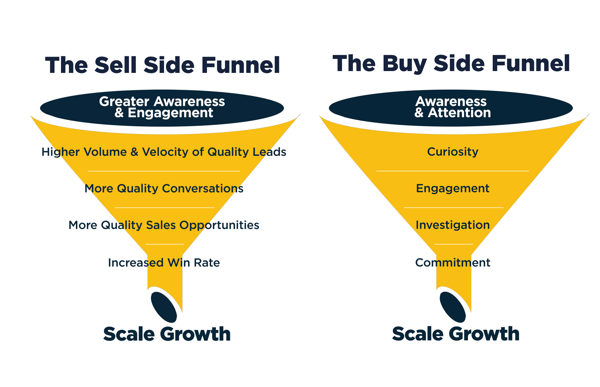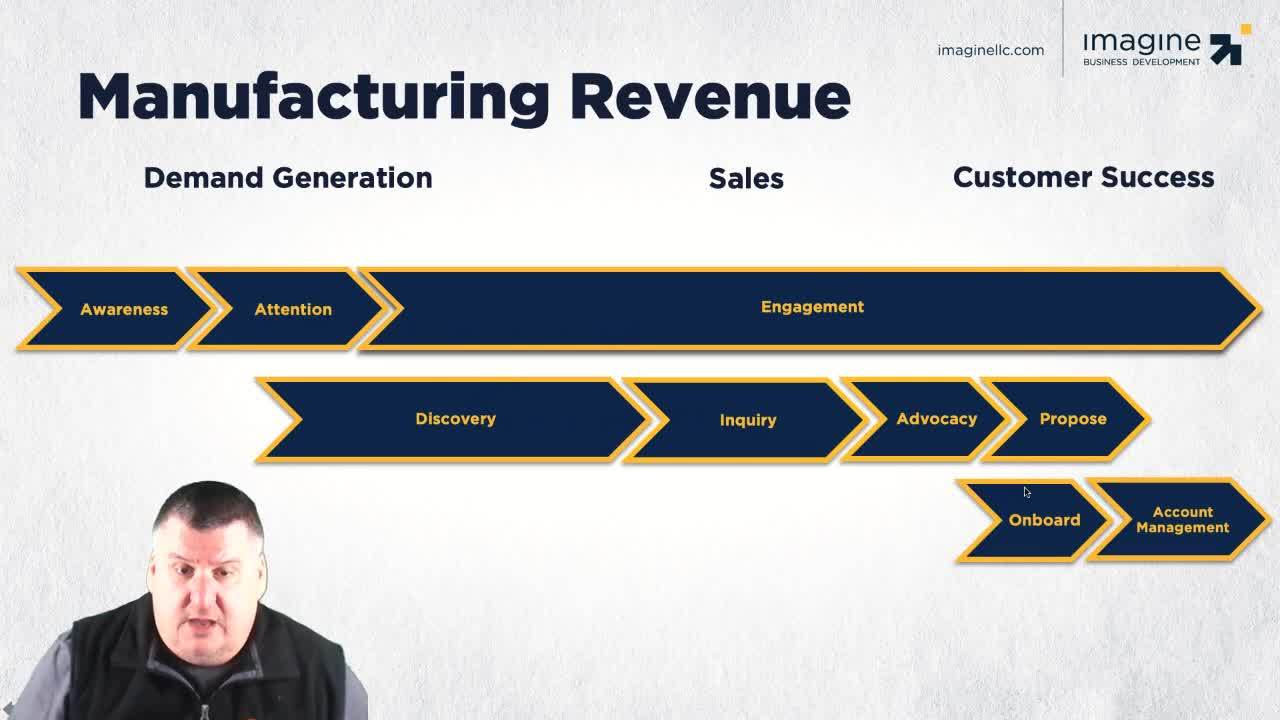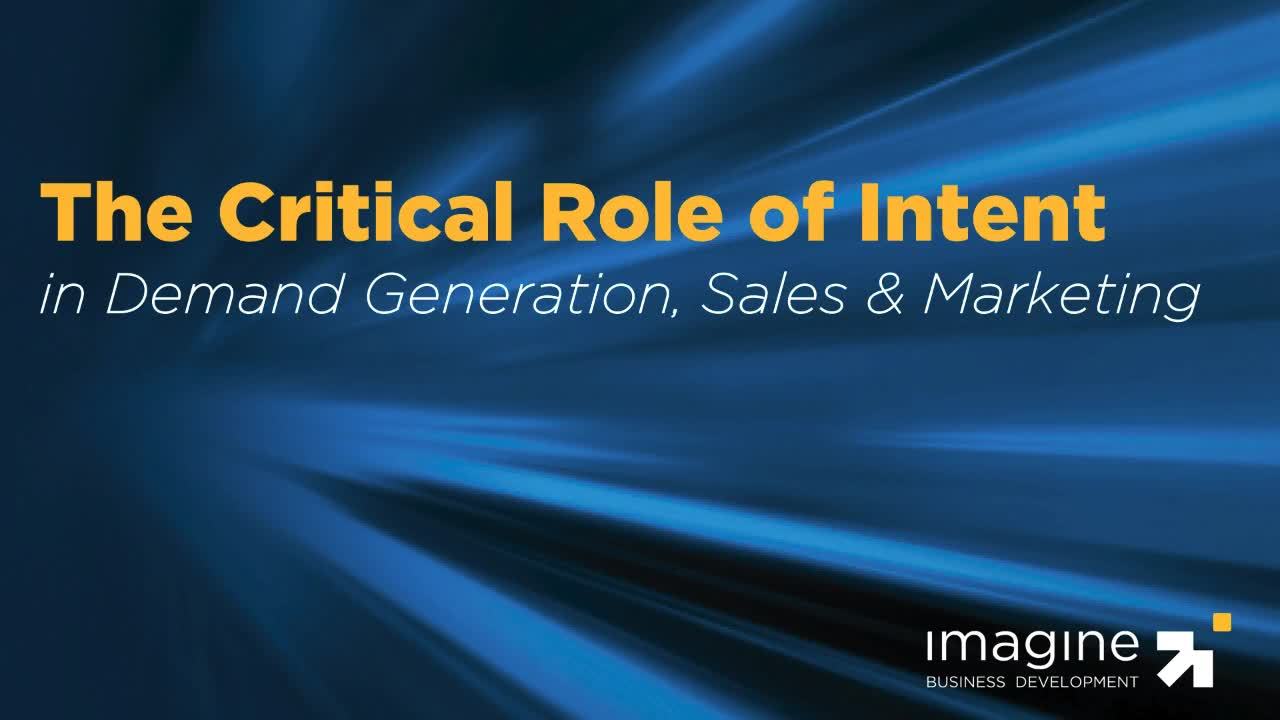 Welcome to part two of our series on understanding the real buyer’s journey. In the first session, I shared the findings of our in-depth analysis of how buyers progress through their journey and take actions that lead to buying. In this session I'm focused on the other side of the equation, how sellers can align with buyers to increase the likelihood of generating engagement, entering conversations, and yes, successfully making sales.
Welcome to part two of our series on understanding the real buyer’s journey. In the first session, I shared the findings of our in-depth analysis of how buyers progress through their journey and take actions that lead to buying. In this session I'm focused on the other side of the equation, how sellers can align with buyers to increase the likelihood of generating engagement, entering conversations, and yes, successfully making sales.
The approach I share today is based on decades of direct experience combined with in-depth analysis, interviews, and studies. My promise is that if you take this approach, you'll gain the following five benefits:
-
You'll be able to design and execute strong customer acquisition programs much more easily.
-
You'll gain greater predictability and repeatability in your customer acquisition efforts, and therefore
-
You’ll gain greater scalability.
-
You'll dramatically increase the results from the marketing and sales efforts that you are taking.
-
You'll lower your overall costs for acquisition (CAC) and position yourself for an extraordinarily strong customer success program and your team will be happier and healthier.

Let's talk about how you can start manufacturing revenue. If you want to generate revenue, you're basically looking at three key processes: the demand generation process, the sales process, and the customer success process. Demand generation is all about creating that awareness, attention, and engagement. Think about this for a moment. How many sales can you make to somebody who's not aware of you, or who's not engaged with you? None. Your demand generation process puts a ceiling on sales growth potential, as well as how hard and how much money you’ll have to spend to make those sales.
The next phase in the process is the customer acquisition process, aka the sales process, the job of turning that attention and engagement into customers. The amount of attention and engagement that exists and the depth of that attention and engagement will have a tremendous impact on many things: the velocity and effectiveness of your customer acquisition efforts, your cost of customer acquisition, and what you have to retain customers. And, of course, your rate of new customer growth is going to be a major contributor to your ability to grow revenue, and ultimately profit (and, yes, for all my SaaS friends, profit still matters).
To sustain growth and scale, the rate of growth of the preceding process must be greater. So you must be generating demand at a higher rate than the rate of your customer acquisition, and your rate of new customer growth must be greater than revenue growth. If that’s not happening, you’ll hit major turbulence, your growth rate will slow (or halt), CAC costs will increase, and churn will kill.
The Demand Generation Process is really about three key components. Creating awareness, turning awareness into attention and attention into engagement. Engagement is the crucial piece of the puzzle throughout the entire customer acquisition and customer success process. Think of it this way, engagement is the elixir of growth.

The Sales Process is all about gaining new customers. I'm a firm believer that your sales process, the pipeline stages and methodology should be built specifically for you. That said, every sales process has four main components:
-
The discovery phase where buyer and seller meet.
-
The inquiry phase, where the seller learns about the buyer and their needs.
-
The advocacy phase where the seller makes recommendations and encourages a prospect or customer to do something.
-
The proposal stage where a seller puts forth a proposal, quote or takes some other action to get the prospect/customer to actually buy.

The Customer Success Process is all about generating revenue, which is done by delighting the customer and, often, increasing what the customer is buying from you. Customer success approaches can be quite complex and vary widely, but the two main components they all share are onboarding and account management (whether it’s called account management or something else).

Manufacturing Revenue
Note: If you have not read the blog post or watched the video on The Real Buyer’s Journey, I highly encourage you to do so now, as the process I’m about to walk through assumes you are familiar with the buyer side.
Awareness
The manufacturing process begins by creating awareness. When executing your awareness tactics, realize that your market is in one of two conditions:
-
Likely 90% or more are not thinking about anything that relates to you or your offering. They’re in an “unconscious” zone, focused on, well, whatever they happen to believe is important to them at the time.
-
The rest are paying attention to something that does connect to you. Note that whatever they are paying attention to has been heavily influenced by stimuli that occurred much earlier, much as which they are not even aware of.
Regardless of the condition to generate awareness your message, content, and tactics must align to what is on their mind and to what they are paying attention to. The rule here is that your job is to think like the person you are trying to connect with, not to require them to think like you.
Attention
The difference between awareness and attention (IMHO) is the former is passive and the latter is active. We are all aware of many things that we are not paying attention to. Just this morning I read a very interesting blog post that related to influence. However, I can’t remember what the title of the post was, who wrote it or what website it was on. I’m paying attention to influence (probably because of the research that we’ve just finished) and I became aware of the blog post I just referenced.
The ultimate of demand generation is when your content or conversation creates that moment when passive awareness becomes active attention. It can be just as effective, however, to “ride the attention wave.” Doing either requires that your tactics do two things:
-
Illuminate something new – typically a problem or opportunity that was either unknown or misunderstood.
-
Highlight the impact or consequences of action or inaction.
Engagement
The elixir of growth. Engagement is where relationships get formed. The power of engagement, from a seller’s perspective at least, is that the prospect begins investing in you. The time they spend engaged with your company is quite valuable.
To manufacture revenue for your business, you must be able to calibrate that engagement. Too often sellers go into full “sell mode” (sometimes very aggressively) at the first sign of engagement, when they would have been far better off to allow the prospect to invest in the seller a bit more.
Discovery
Your sales process should begin before there’s a defined sales opportunity. Ideally, you begin executing your sales tactics at the attention stage and those tactics encourage and nudge the prospect to engagement. (This can be the power of sales/business/market development reps.)
The discovery process should be focused on generating curiosity, alignment, and a willingness to investigate and dig deeper. Keep in mind that when you ask a buyer to engage in any type of buying/selling process, you are asking them to make an investment – be sure you’ve done enough to this point so they’ll willingly make the investment.
Inquiry
Inquiry goes by many names. At Imagine, we call it diagnosis; others call it needs assessment, qualification, etc. The main point is that this is where the process truly becomes a selling process.
Now, this post is not a treatise on the sales process (we’re working on that in another post), and the details of what happens once you get to this point of the process will vary greatly by how your sales process is designed.
The Absolutely, Positively Most Important Component of Generating Predictability and Therefore Being Able to Manufacture Revenue
If you want to build predictability into your revenue creation platform, then you must understand where and when intent occurs.
The buyer intent I’m talking about here is that point in the decision process when the prospect decides that something must be done, and that change must occur. They will not have (at least officially) decided who they are going to buy from. They may not have even decided that they are going to buy from anyone. They have decided that they must do something.
I was doing some research recently on conversion benchmarks. The conversion rate from generating a sales qualified lead to customer is somewhere between 4.5% - 8%, with the top performers touching just above 9%.
Just imagine for a moment if the head of manufacturing was reporting his yield KPI to the CEO, and it looked like this:
CEO: Frank, what’s our production yield like this quarter?
VP: Well, Susan, from which point in the process?
CEO: From the beginning Frank. From the time we put the raw material onto the line.
VP: We’re having a great quarter. We’re coming in at just under 9%.
CEO: Wait, you’re telling me that we’re wasting 91% of our resources and I’m supposed to think that’s great?!
Growth-focused companies are increasing head counts, spending more than ever on technology, increasing headcount for both sales and marketing, and while most are certainly seeing revenue growth today, that growth rate is trailing the rate that costs are growing and the delta between the two is getting bigger. (Imagine what that means when the economy isn’t red hot.) The road is simply not sustainable, and there are two reasons for this:
-
Sellers are treating all lead types (pre- and post-intent) the same.
-
Selling too early (before intent) or too late (there’s intent, but we had little to no influence on it).

The key to manufacturing revenue is to look at the whole process in two parts: the pre-intent phase and the post-intent phase. The pre-intent phase is the investment portion of the customer acquisition process, post-intent is the withdrawal phase. You win the sale if your account balance is the highest among the alternatives your prospect is considering. The key to ensuring that you don’t overdraw your account is to be sure that you invest adequately, early.
Take this approach and customer acquisition and revenue becomes predictable, just like manufacturing a product. In our next post in our series on the real buyer’s journey, we’ll be focusing on the key elements needed to align your approach with the buyer’s approach.

 Doug Davidoff
Doug Davidoff